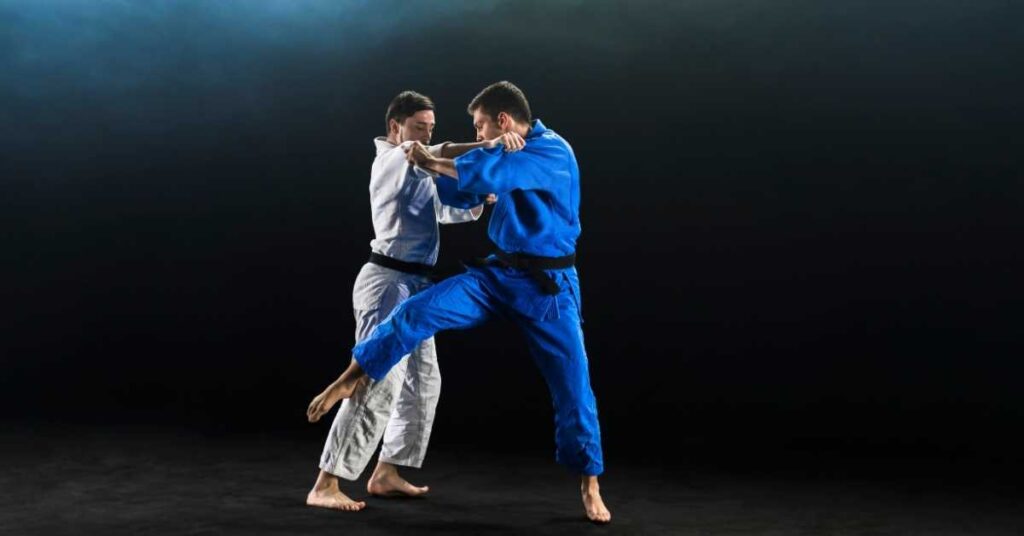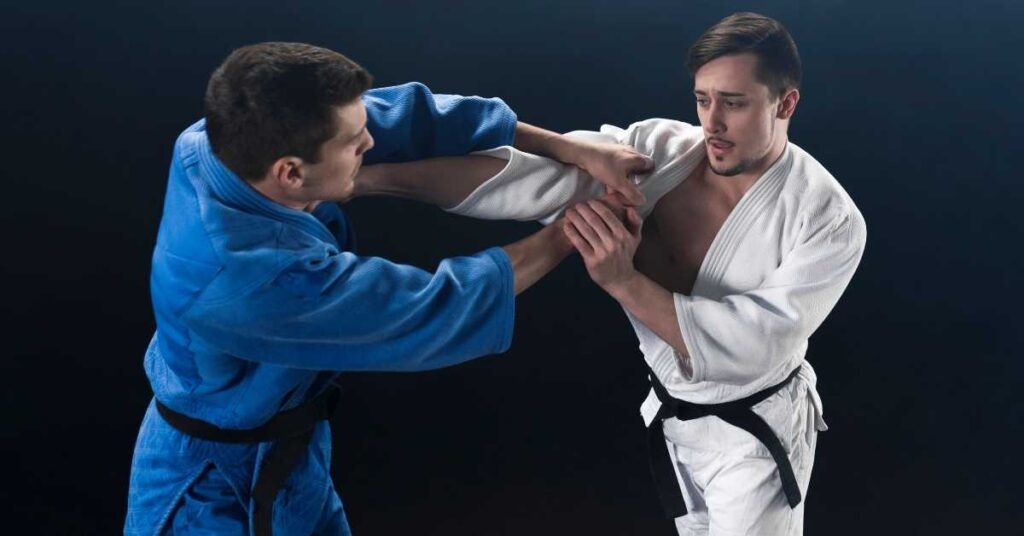Is Judo offensive or defensive? Judo is both offensive and defensive. It brings the two together into a martial arts discipline that uses a combination of throws and flips to take advantage of their opponents and uses that to neutralize them.
Did you know that Judo is one of the most popular martial arts in the world? With over 20 million practitioners worldwide, it is a sport that has captured the attention of many.
But have you ever wondered whether Judo is offensive or defensive?
In this article, we will explore the philosophy of Judo and delve into the principles of redirecting energy. We will discuss both defensive and offensive techniques in Judo, highlighting the importance of timing and strategy.
Moreover, we will examine how practitioners train to develop both offensive and defensive skills, and the delicate balance between the two in Judo.
Whether you are a seasoned Judoka or simply curious about this fascinating martial art, this article will provide you with valuable insights into the offensive and defensive aspects of Judo.
So, let’s get started and unravel the mysteries behind this ancient sport!
Key Takeaways
- Judo combines offensive and defensive techniques.
- Judo emphasizes using an opponent’s strength against them.
- Timing and strategy play a crucial role in Judo.
- Finding the right balance between aggression and defense is important in Judo.
Is Judo Offensive or Defensive?
Judo is often seen as a martial art that combines offensive and defensive techniques to create a well-rounded and adaptable fighting style. Judo techniques encompass a wide range of moves that can be used for both offensive and defensive purposes.
Judo emphasizes the importance of using an opponent’s strength against them, which requires a strategic approach that includes both offensive and defensive maneuvers. Judo self-defense techniques focus on using an opponent’s momentum and leveraging their body weight to neutralize threats.
Judo throws are a key component of this martial art, allowing practitioners to take control of a confrontation by using an opponent’s own force to throw them to the ground. Judo ground techniques also play a crucial role in both offensive and defensive scenarios, providing effective grappling and submission holds to immobilize opponents.
By combining offensive and defensive techniques, Judo offers a comprehensive fighting style that is adaptable and effective in various situations.
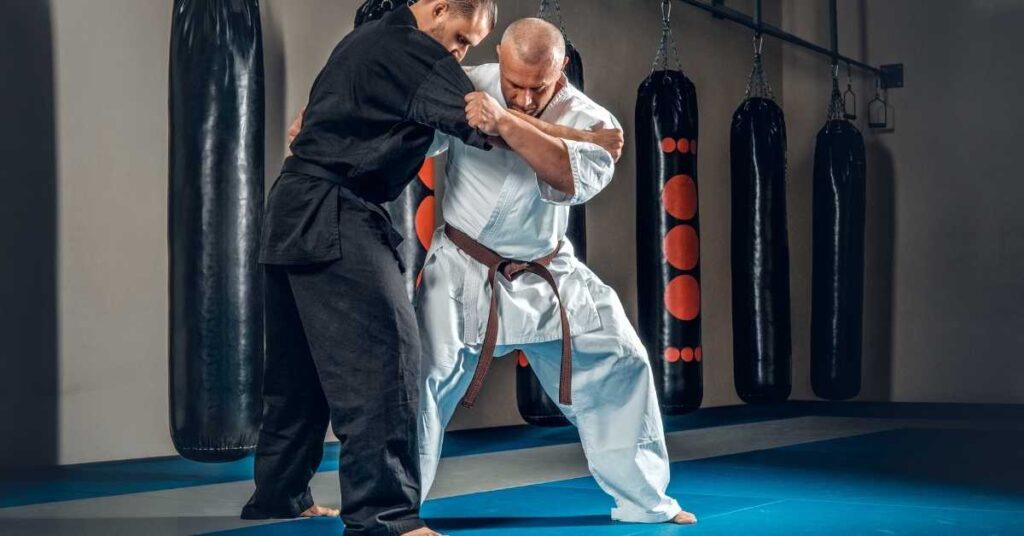
What is The Philosophy of Judo?
Steeped in a profound philosophy of balance and harmony, the art of Judo embodies a captivating dance between control and adaptability. Judo’s moral code, known as the ‘Judo Kyohan,’ serves as the guiding principle for practitioners, emphasizing respect, discipline, and mutual benefit.
Influenced by Zen philosophy, Judo encourages practitioners to cultivate a focused and present mindset, allowing them to respond instinctively to their opponent’s movements. While Judo is often seen as a defensive martial art, it also has a crucial role in self-defense.
By utilizing an opponent’s strength and momentum against them, Judo practitioners can effectively neutralize threats without resorting to offensive tactics.
Discipline is paramount in Judo, as it promotes mental and physical development, fosters self-control, and instills a sense of belonging within the Judo community.
Principles of Redirecting Energy
Cultivating a mindset of focus and presence allows you to instinctively respond to your opponent’s movements, utilizing their strength and momentum to effectively neutralize threats in the art of Judo. Energy redirection techniques play a crucial role in this process.
By skillfully redirecting your opponent’s energy, you can disrupt their balance and create openings for your own attacks. The importance of balance cannot be overstated in Judo. By maintaining your own balance while simultaneously destabilizing your opponent, you can control the flow of the match.
Utilizing your opponent’s force is another key principle in Judo. Instead of resisting or directly opposing their strength, you learn to harness it and use it to your advantage. This efficient use of strength allows even smaller individuals to overcome larger opponents.
Strategic positioning is also vital in Judo. By positioning yourself correctly, you can maximize your leverage and increase the effectiveness of your techniques.
Defensive Techniques in Judo
To effectively defend against your opponent’s attacks, you can use techniques such as the ‘Uki Otoshi’ throw, which involves redirecting their momentum to throw them off balance and create an opportunity for a counterattack.
In addition to throws, judo offers a variety of defensive techniques that can be used to protect yourself and regain control of the match.
Defensive grips play a crucial role in judo, allowing you to control your opponent’s movements and limit their options for attacking.
Evading techniques, such as footwork and body movement, can also help you avoid your opponent’s attacks and create openings for counterattacks.
Blocking techniques provide another layer of defense, allowing you to block strikes and immobilize your opponent.
Lastly, escape moves are essential for getting out of compromising positions and avoiding being pinned down.
By mastering these defensive techniques, you can effectively defend yourself and create opportunities for counterattacks in judo.
Offensive Techniques in Judo
When it comes to attacking in judo, you need to focus on using your opponent’s momentum and balance to your advantage. Counterattacks are a key offensive technique in judo. By timing your attack correctly, you can use your opponent’s movement against them, throwing them off balance and taking control of the situation.
Gripping strategies are also important in judo offenses. By establishing a strong grip on your opponent’s gi, you can control their movements and set up your own attacks.
Sacrifice throws are another offensive technique in judo. By sacrificing your own balance, you can use your opponent’s momentum to execute a powerful throw.
Combination techniques involve stringing together multiple techniques to create a fluid and effective attack.
Finally, ground fighting techniques are used to gain control and submit your opponent once the fight goes to the ground.
Overall, judo offers a variety of offensive techniques that can be utilized to gain an advantage over your opponent.
The Role of Timing and Strategy
Ironically, it’s amazing how a well-timed strategic move can completely turn the tables in a judo match. Timing tactics play a crucial role in judo, as the ability to anticipate your opponent’s moves and execute your techniques at the right moment is key to success.
Strategic positioning is another important aspect, where you aim to place yourself in a favorable position to launch effective attacks or defend against your opponent’s moves. By studying your opponent’s patterns and weaknesses, you can identify counterattacking opportunities and exploit them to your advantage.
However, it’s important to maintain a defensive mindset while executing these techniques, as being overly aggressive can leave you vulnerable to your opponent’s counterattacks. In judo, offensive techniques are not solely about attacking; they are about using timing, strategy, and awareness to gain the upper hand in a match.
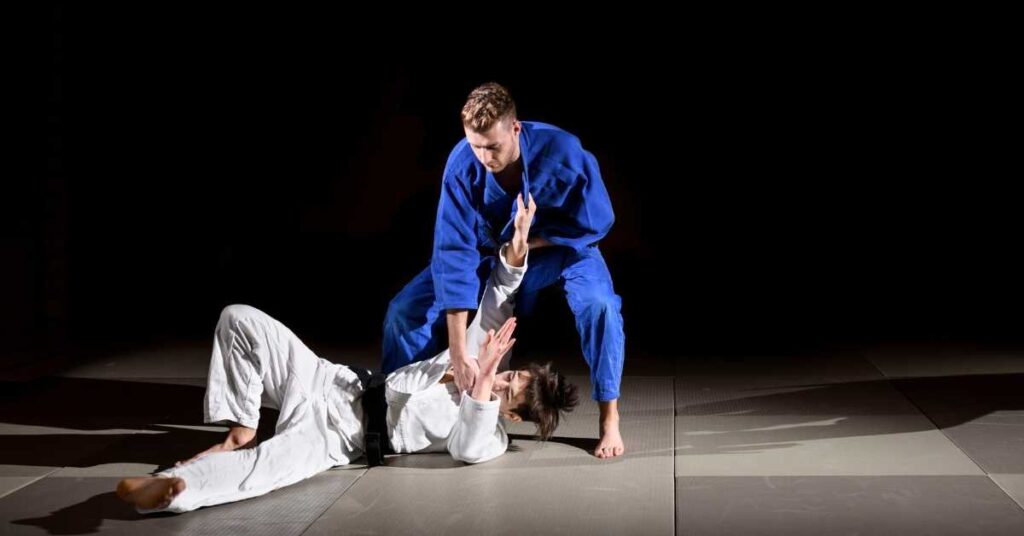
Training for Both Offensive and Defensive Skills
Strategically honing your skills in both attacking and defending is essential for becoming a well-rounded judoka. To excel in judo, you need to develop a deep understanding of counterattacking techniques, joint locks, grip fighting, countering throws, and tactical positioning.
By training in these areas, you will be able to effectively respond to your opponent’s attacks and create opportunities for your own offensive moves.
Learning counterattacking techniques allows you to swiftly capitalize on your opponent’s openings, turning their attacks into opportunities for your own success. Understanding joint locks gives you the ability to immobilize and control your opponent, forcing them to submit or create openings for your own offensive maneuvers. Grip fighting is crucial for gaining control over your opponent’s movements and setting up your own attacks.
Additionally, countering throws is a vital skill in judo, as it allows you to neutralize your opponent’s attempts to throw you and quickly turn the tables in your favor. Lastly, mastering tactical positioning enables you to anticipate your opponent’s moves and strategically position yourself for both offensive and defensive actions.
By training in these offensive and defensive skills, you will become a well-rounded judoka, capable of adapting to any situation on the mat. Remember, judo isn’t solely about overpowering your opponent but also about outsmarting them through a combination of technique, timing, and strategy.
The Balance Between Offense and Defense in Judo
Finding the right balance between your attacks and defenses is crucial in judo, as it can make the difference between victory and defeat. In judo, there is a constant interplay between attack and counter.
While offense involves initiating a technique, defense requires reacting to an opponent’s attack. To achieve success, judo practitioners must master the art of balance and control. This involves understanding when to be aggressive and when to be defensive, as well as seamlessly transitioning between the two.
Another key aspect of finding this balance is utilizing your opponents’ momentum to your advantage. By redirecting their energy, you can gain the upper hand in a bout. Lastly, tactical decision-making plays a significant role in achieving the right balance. Knowing when to attack and when to defend requires strategic thinking and adaptability on the mat.
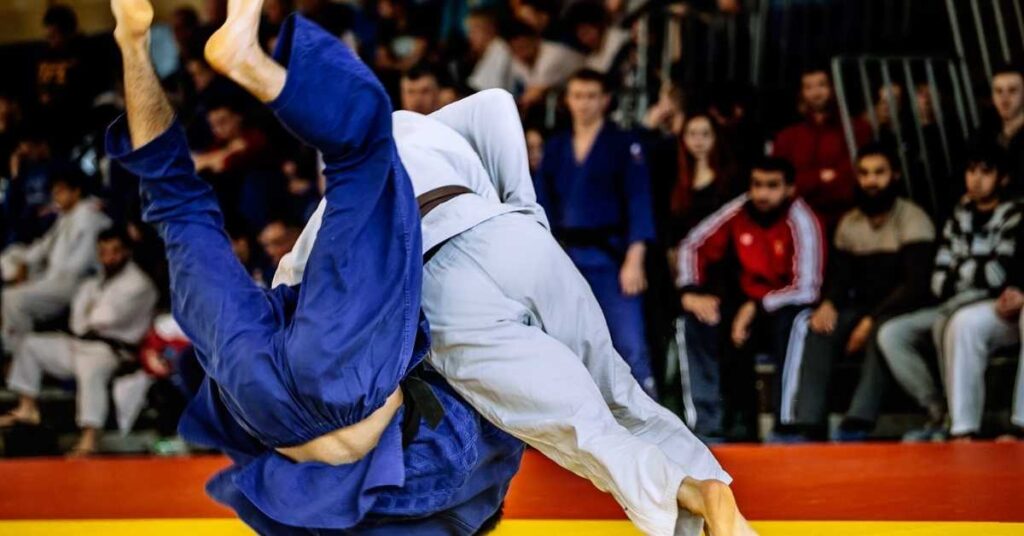
Frequently Asked Questions
Here are some common questions about Judo:
Can Judo be used for self-defense?
Yes, Judo can be used for self-defense. Judo techniques are effective for self-defense applications and can be learned by beginners. Compared to other martial arts, Judo is particularly useful in real-life situations.
How does Judo differ from other martial arts in terms of offense and defense?
Judo differs from other martial arts in terms of offense and defense. In Judo vs. Karate, Judo focuses more on offensive strategies like throws and holds. Counterattacks play a crucial role in Judo’s defensive techniques. Timing is vital in executing both offensive and defensive maneuvers.
Are there any specific offensive techniques in Judo that are more effective than others?
In judo, there are several offensive techniques that can be highly effective. Counter techniques allow you to capitalize on your opponent’s movements, while sacrifice throws can quickly turn the tables. Arm locks, leg sweeps, and grip fighting are also key strategies to gain an advantage.
What are some common misconceptions about the offensive and defensive aspects of Judo?
Common misconceptions about judo include the belief that it is solely offensive or defensive. In reality, judo incorporates both offensive and defensive techniques, with an emphasis on self-defense effectiveness. The philosophy of judo influences its approach to combat.
How does the philosophy of Judo influence the balance between offense and defense in the sport?
The philosophy of Judo heavily influences the balance between offense and defense in the sport. Judo’s mindset influence and tactical strategies are rooted in its philosophical principles, which emphasize using an opponent’s strength against them.
Conclusion
In conclusion, whether judo is offensive or defensive ultimately depends on the practitioner’s approach and strategy. The philosophy of judo emphasizes redirecting energy and using an opponent’s strength against them, which can be seen as both defensive and offensive.
Defensive techniques in judo focus on avoiding attacks and maintaining control, while offensive techniques aim to throw or submit an opponent. By training in both offensive and defensive skills, judo practitioners can achieve a balanced approach that allows them to adapt and respond effectively in any situation.

